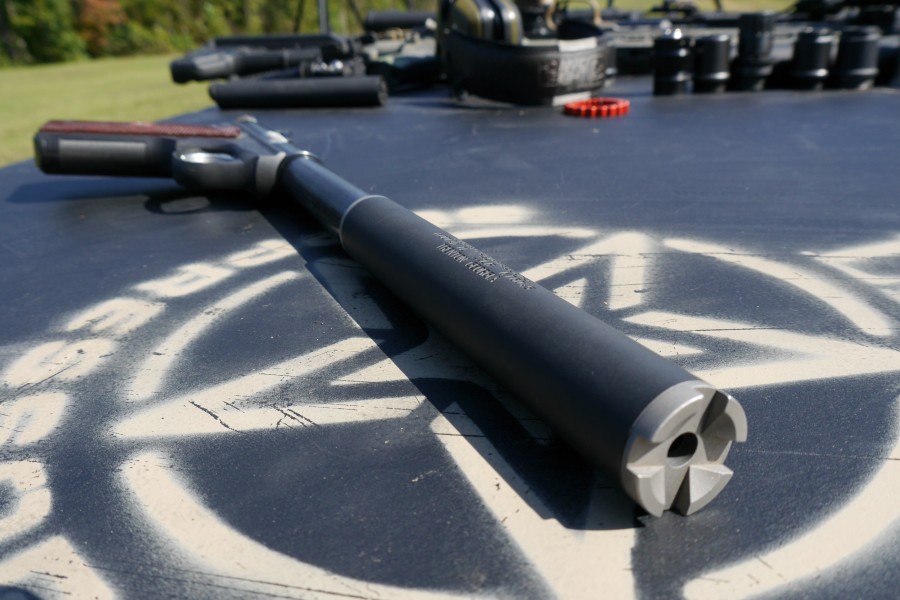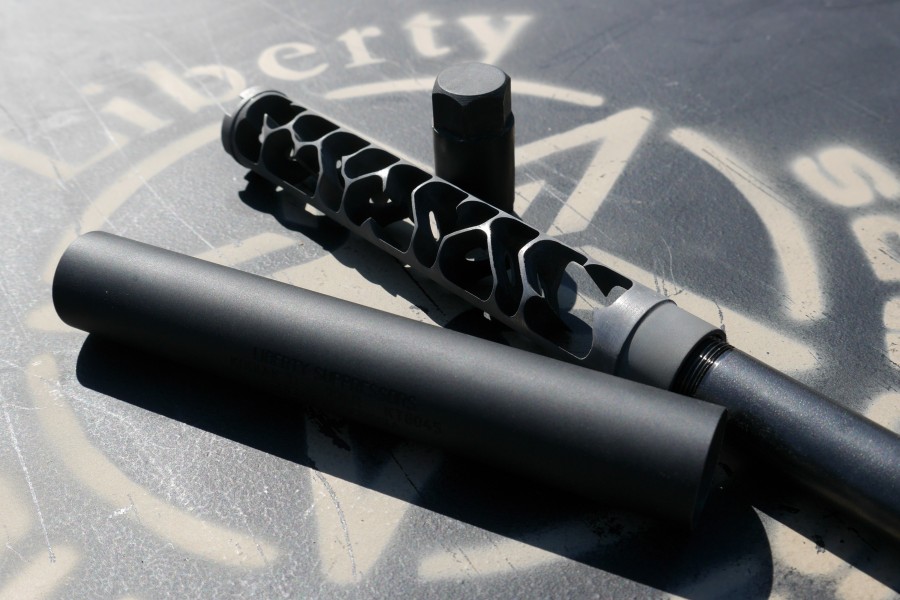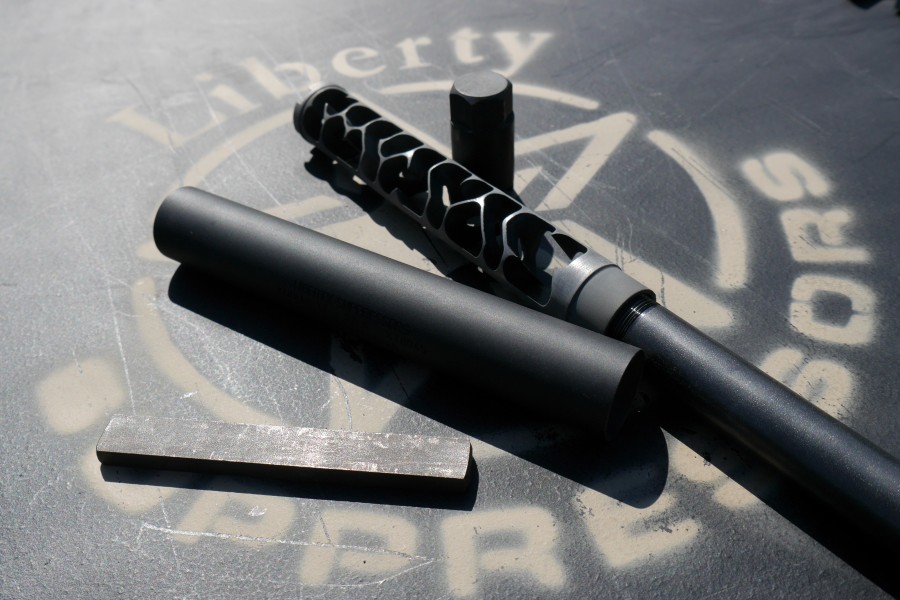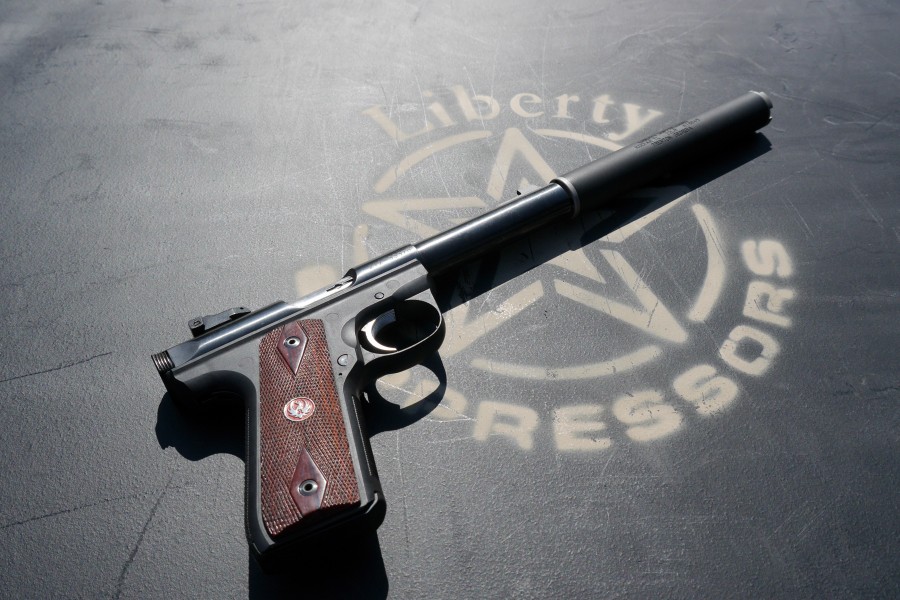Bigger doesn’t always mean better. With silencers the general rule of thumb is that the larger the internal volume of the can, the better sound suppression you’re going to get, but there’s definitely a point where increased volume gets you diminishing returns. For example, slapping a Mystic-X on your Ruger handgun makes the thing whisper quiet, but the size of the can looks awkward and makes the gun a little front heavy. For the shooter who’s looking for a slimmer solution to their rimfire suppression needs, Liberty Suppressors presents the Kodiak TL . . .
As a preface, I want to point out that this is not a typical TTAG review. We usually reserve judgment until we’ve put at least a couple hundred rounds through something and tried it out in different conditions. Unfortunately the BATFE here in the U.S. prevents us from getting our hands on silencers for protracted testing unless we go through months of waiting, spend $200 per transfer, and live in certain states. It’s annoying, impractical and cumbersome.
Luckily, though, I recently had a chance to visit the folks at Liberty Suppressors and test all of their cans under their supervision. While the tests may not be as extensive as we would conduct in a standard review, I feel that they were sufficient to allow me to form an educated opinion on the product.
When you’re talking about a rimfire suppressor, there are three things that a buyer will look for: ease of cleaning, suppression, and weight — in that order.
Cleaning a rimfire can is more important than with any other caliber simply because rimfire ammunition is about the dirtiest stuff you can imagine — other than J-Roc’s amateur videos. Rimfire ammo leaves more carbon residue, lead dust, and even unburnt powder in the baffles than any other type of ammunition, and getting all that crap out of your can is essential to keeping it running and functional for years to come.
Just about every rimfire silencer on the market these days is designed to be disassembled by the end user for cleaning, but some do it better than others. For example, the AAC Pilot 2 uses a standard “K baffle” design with interlocking cups that makes for great sound suppression, but is a royal pain in the ass to clean. Disassembly also can be problematic, requiring a proprietary tool to remove the end cap and then you need to push all the baffles out of the tube before cleaning (they can get stuck after excessive range trips).
By comparison, the Kodiak TL is a pleasure to disassemble. The end cap is designed such that it can be cranked off using either the Liberty-designed removal tool — or really any old piece of scrap metal will do. Once free, you can either use the Liberty-designed baffle stack holder (that threads into the rear of the stack) or just push it out with whatever is at hand. The Kodiak TL allows you options.
Once the outer sheath has been removed, the monolithic core is fully accessible for cleaning. Just hit it with a hose or your favorite cleaning fluids, let it dry, re-assemble it and you’re good to go. Much easier than trying to individually clean the K baffles in the Pilot 2.
Being easy to clean is nice, but the real test of a silencer is how well it performs its eponymous job. In the case of the Kodiak TL, the answer is pretty damned well. Liberty claims that the can will run under 120 dB even for the louder first round pop, but out on the range it sounded almost whisper quiet. As good if not better than anything I’ve tested.
Where we start to run into a problem is with the Kodiak TL’s size and pricing. Take, for example, AAC’s Prodigy silencer — a can which is currently waiting on a form 4 for me at my local FFL. The Prodigy is easier to disassemble, shorter, weighs half as much, and costs $70 less. But while the Prodigy is a dedicated .22LR only silencer, the Kodiak TL is rated to also accept 17 HMR and 22 WMR. So there’s a definite trade-off when comparing the two silencers, and deciding which one works best for you is all about figuring out which one best suits your needs and shooting style. In the long run, though, the added weight and size seems to me to be an acceptable trade-off for the vastly expanded ballistic repertoire.
In the end, it all depends on what you want. If you need the lightest and smallest silencer possible for your Ruger .22LR handgun, this isn’t it. The Kodiak TL is definitely smaller and lighter than any of the centerfire pistol silencers on the market, but it’s heavier than AAC’s Prodigy. Then again, the Prodigy can’t handle anything above .22LR while the Kodiak TL is capable of much more. For me, the Kodiak TL wins the day due to the greater utility of the device. Then again, your preference may vary.
Liberty Kodiak TL
Length: 6.5″
Weight: 6.3oz
Diameter: 1″
Sound Reduction: 41 dB
MSRP: $560
Ratings (out of five stars):
Sound Suppression: * * * * (*)
There’s an asterisk next to the asterisks here. For the first round, the sound suppression is at about a 4-star level – just about as quiet as anything else I’ve fired. And believe it or not, I’ve fired my fair share of .22LR silencers in my day. But from the second round on this thing is just unbelievable. 5/5 once the oxygen is gone. I’m pretty sure you couldn’t make it any quieter.
Build Quality: * * * * *
A solid monocore design for the baffle stack means an easy-to-disassemble silencer and a solid chunky feeling to the whole can. Overall it feels like this thing has been over-engineered and looks great.
Ease of Use: * * * * *
Cleaning might require some tools to get the can apart, but once you break the seal everything is very easy to clean.
Overall Rating: * * * *
It’s heavier and more expensive than the AAC Prodigy, but it has a wider array of calibers it will work with. I like it.








Looks impressive, but doesn’t meet my criteria of 80-85% noise reduction.
Is that an area under the curve measurement or a more linear 80-85%.
Good luck.
Sure it does. Double or twice the sensed loudness of something is roughly 10dB increments.
An unsuppressed 22LR pistol is almost 160dB. A quality silencer brings it down to about 120dB. That’s a HUGE 40dB noise reduction…. way beyond your “80-85% requirement.”
Decibels are a logarithmic scale. For every ten decibels you go up the scale the “loudness” of the sound increases tenfold. Likewise, every ten decibels down the scale corresponds to a 90% reduction in sound.
Most silencers reduce the sound level of a firearm by 20-40dBa corresponding to a sound reduction of approximately 99-99.99%
Every single firearm silencer on the market meets your criteria. What you really should be looking at are hearing safe volume levels. According to OSHA instant hearing damage occurs at sound levels above 140dBa, so any silencer that reduces the sound of a shot below this level is “hearing safe” for short periods of time. Of course, the lower the dBa rating the more exposure you can tolerate before experiencing permanent damage.
Just to put that in perspective, a silencer like you proposed, with an 80-85% reduction in sound level would take a firearm from the 160-165dBa range to the mid 150s, still very much not hearing safe.
We need to get a grassroots effort to seriously push the silencer off the NFA list. We should emphasize they are completely legal and unregulated in places like the UK. Show some pictures with Teddy Roosevelt with a silencer on his rifle.
Its starts by normalizing them so everyone needs to buy a silencer.
If it were any product other than a firearm, silencers wouldn’t just be unregulated, they’d be required by law.
They are called mufflers
For the suppressor illiterate, why is the first round louder than the others?
I’m not an expert – they say it is the oxygen in the can. I guess when the round is fired there is more oxygen available to burn any unused powder inside the can?
First Round Pop(FRP) is loudest in monocores. My Element 2, and Spectre II sound the same, from first to last shot, but they use K, and CTA baffles respectively.
Point of contention: aluminum is a pain in the ass to clean. No caustic chemicals, no ultrasonic, you are left with soda blasting and even that is a time bomb of failed materials (eventually)
Friends don’t let friends but non-user-serviceable cans and friends unfriend friends who buy aluminum-baffled cans.
Nick, make sure you clean your prodigy after every 200rds. Or you will eventually wonder why it keeps getting louder.
I know a guy that uses an ultrasonic cleaner on his aluminum Silencerco Sparrow without apparent ill effects. Why are you saying it’s bad?
Raw and clear anodized aluminum can be cleaned quite satisfactorily in an ultrasonic cleaner. Just use the correct detergent – automatic dishwasher detergent with a little TSP added or proprietary detergents like Alconox work well and do not harm the substrate. Run the cleaner solution hot to lift wax soils: 160 F plus.
Ultrasonic cleaning can remove the dyes which color aluminum anodizing. Aluminum parts allowed to rest on the bottom of ultrasonic cleaner tanks can suffer surface damage. These are the two issues with cleaning aluminum in an ultrasonic cleaner.
That’s gotta be an OLD sparrow, if its Al.
He is damaging it every time he runs it in the USC. The cavitation cleaning effect is stripping the anodizing, and pitting the aluminum.
Does TTAG have an article comparing all or many of the currently available .22 silencer/suppressors? I’ll be starting my stamp collection next year with a silencerco sparrow I think, though some of these reviews might change my mind.
It’s great that TTAG does mention silencers every so often, but for way deeper research head over to Silencertalk.
And the Sparrow is a great can! Generally THE best 22LR silencer on the market. But I actually recommend something like the Mystic X as a first can. That way you can start enjoying shooting multiple calibers right away, instead of being stuck on just 22LR for quite another while.
I have no experience with Mystic but I can safely say that you can’t go wrong with either the Sparrow or Spectre II. They’re both multi caliber rated (up to 5.7×28) and easy to clean. I’d lean towards the Spectre because it offers the same performance for $100 less, though it’s a bit longer and heavier.
I liked the review, but disagree with the importance of cleaning on all cans. Look at the Thunderbeast rimfire cans. Because they are non-user-serviceable, they are made to tighter tolerances. If you really must clean, send it to them and they will clean it once a year for free. Read the literature. I have thousands of rounds through my 22-1, and it’s never been cleaned.
Yup you guys totally skipped over the benefit of stainless steel and how much of a pain aluminum baffles are to clean.
Been enjoying trailer park boys on Netflix, have you?
Comments are closed.